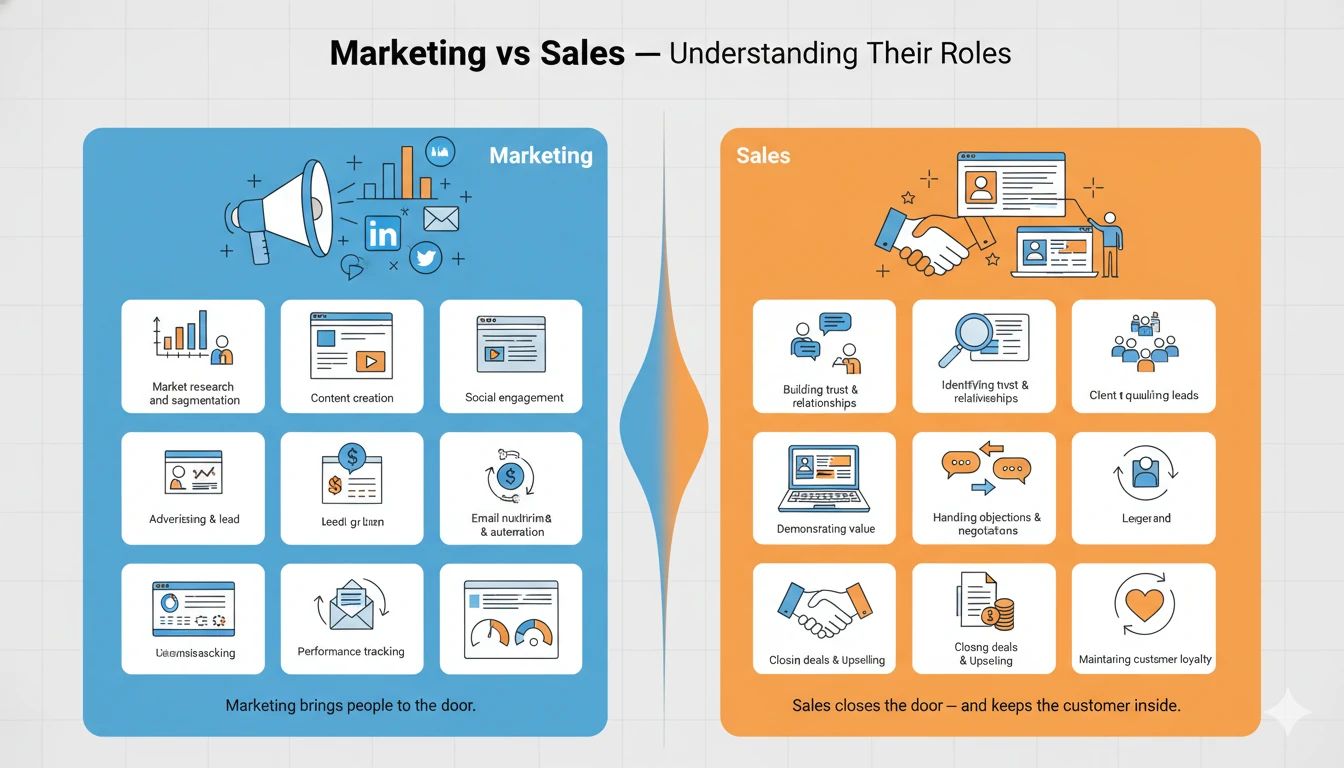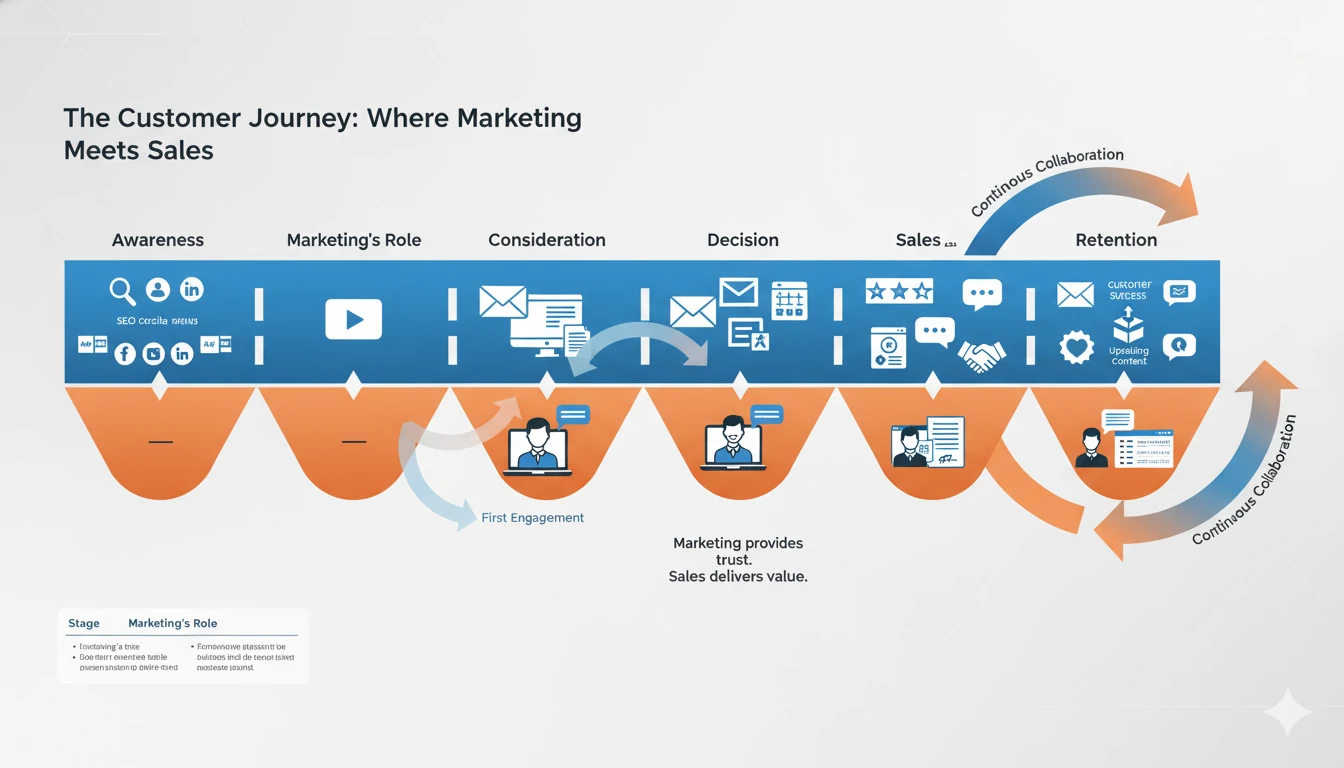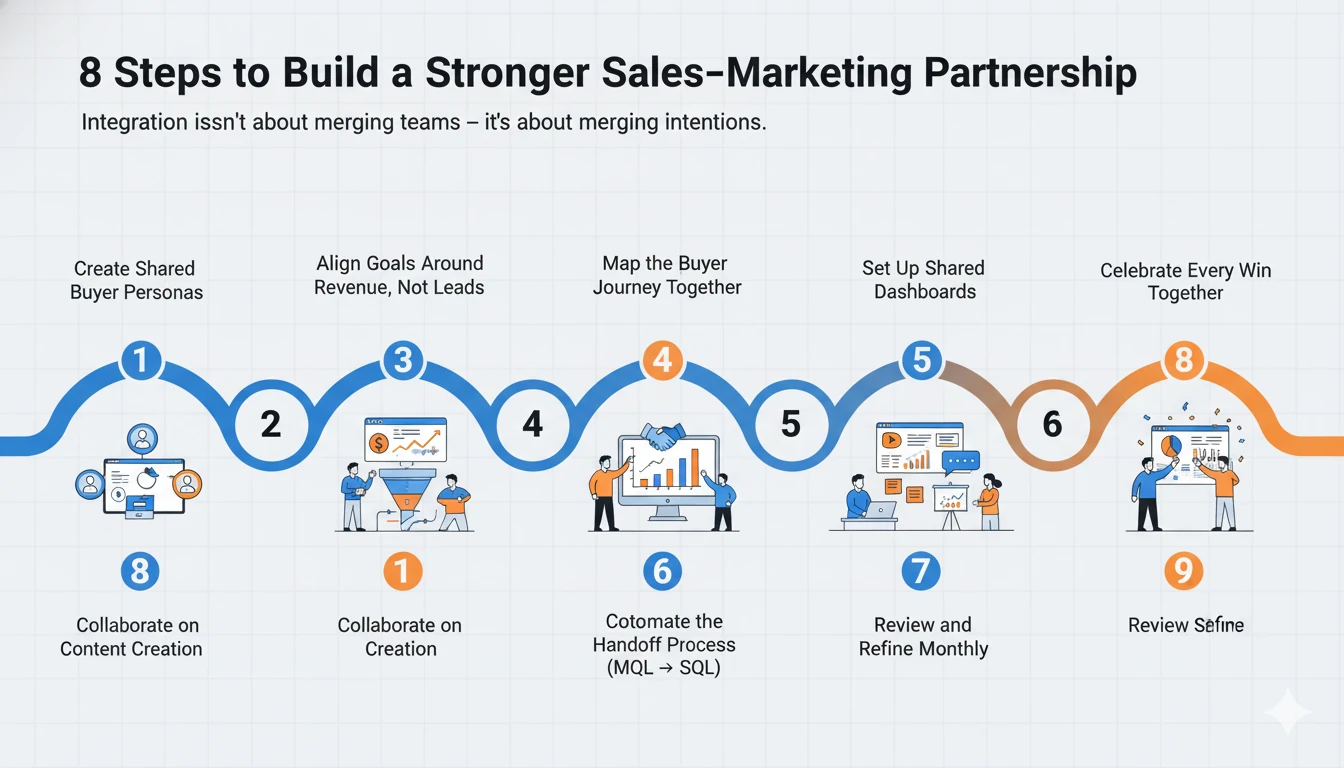In today’s hyper-connected digital world, customers don’t move from awareness to purchase in a straight line. They read, research, compare, and expect personalized engagement at every stage.
That’s why in 2025, the partnership between marketing and sales isn’t just helpful — it’s essential.
When these two functions work in harmony, they create a unified customer journey that drives stronger leads, faster conversions, and long-term loyalty.
Let’s explore how marketing and sales work together, what integration looks like, and how to build a system that truly drives growth.

1. Understanding the Roles: Marketing vs Sales
Before understanding how they work together, let’s clarify what each function does — and how their goals connect.
Marketing: The Engine of Awareness and Demand
Marketing focuses on creating awareness, interest, and desire among potential customers. It’s the process of educating the audience about the brand’s value before they talk to a salesperson.
Key functions of marketing include:
Market research and segmentation
Content creation (blogs, videos, guides)
Social media and brand engagement
Advertising and lead generation campaigns
Email nurturing and automation
Performance tracking and optimization
In simple terms, marketing brings people to the door.
Sales: The Engine of Conversion and Retention
Sales takes over where marketing leaves off — by turning those engaged prospects into paying, long-term customers.
Key functions of sales include:
Identifying and qualifying leads
Building relationships and trust
Demonstrating value through calls, demos, and meetings
Handling objections and negotiations
Closing deals and upselling
Maintaining customer relationships post-purchase
In short, sales closes the door once marketing opens it — and keeps the customer inside for the long term.
2. Why Marketing and Sales Collaboration Matters
According to Salesforce, companies with aligned sales and marketing teams see a 36% higher customer retention rate and 38% higher sales win rates.
Yet, in many businesses, these departments still operate in silos — marketing blames sales for “not following up,” and sales blames marketing for “bad leads.”
Here’s why alignment matters:
Shared goals = shared success. Both teams ultimately drive revenue.
Better lead quality. Marketing attracts prospects sales can actually close.
Faster sales cycles. Educated leads need less convincing.
Consistent messaging. Customers hear one story, not two.
Data synergy. Shared analytics reveal what truly drives conversions.
Cognism Insight: Companies that integrate sales and marketing generate 208% more revenue from marketing efforts.

3. The Customer Journey: Where Marketing Meets Sales
To understand collaboration, visualize the modern B2B or B2C funnel. It’s not linear — it’s interconnected.
| Stage | Marketing’s Role | Sales’ Role |
|---|---|---|
| Awareness | Build brand visibility through SEO, content, ads | — |
| Consideration | Educate and nurture leads via email, webinars, and case studies | Start light engagement and answer questions |
| Decision | Provide trust assets (reviews, ROI tools, comparisons) | Demonstrate product value and close the deal |
| Retention | Run loyalty campaigns, email updates, and upselling content | Manage relationships, renewals, and customer success |
The handoff between marketing and sales isn’t a single moment — it’s a continuous collaboration that keeps the customer experience seamless.
4. The Anatomy of Alignment: How Marketing and Sales Work Together
Let’s break down the major ways these two departments collaborate successfully in 2025.
4.1 Shared Strategy and Goals
The first step is to define common objectives.
In traditional models, marketing aims for leads, while sales aims for deals — but that gap leads to friction.
Modern teams align around shared KPIs like:
Revenue generated
Conversion rates per campaign
Cost per acquisition (CPA)
Customer lifetime value (CLV)
Retention and referral rates
Both teams should agree on what defines a qualified lead (MQL → SQL) to prevent wasted effort.
Pro Tip from Funnel.io: Hold regular “smarketing” meetings to review funnel performance together — not separately.
4.2 Consistent Messaging
When marketing and sales use different language to describe your product, customers get confused.
To fix this:
Build a shared messaging playbook — including tone, key benefits, and value statements.
Use real feedback from sales calls to adjust marketing copy.
Keep campaign assets and sales materials aligned under the same brand story.
This ensures that from the first ad click to the last sales call, customers experience one unified brand voice.
4.3 Lead Qualification and Handoff
The handoff from marketing to sales is a critical moment.
If marketing sends unqualified leads, sales wastes time. If sales doesn’t follow up fast enough, leads grow cold.
To solve this, define:
MQL (Marketing Qualified Lead): A lead that meets engagement criteria (e.g., downloaded an eBook, attended a webinar).
SQL (Sales Qualified Lead): A lead verified by sales as ready for direct conversation.
Automation tools like HubSpot, Salesforce, and Marketo can track lead scoring, engagement, and instantly transfer hot leads to the right rep.
4.4 Data Sharing and Analytics
Data alignment is the heart of collaboration.
When both teams have access to the same CRM and analytics dashboard, decisions become faster and smarter.
Shared metrics might include:
Traffic-to-lead conversion rate
Lead-to-customer rate
Campaign ROI
Average deal size
Customer acquisition cost (CAC)
Salesforce Research: Businesses that integrate CRM and marketing analytics see 30% faster deal closures.
4.5 Content Collaboration
Marketing creates content — but sales uses it.
Both should collaborate on what kind of materials help close deals.
Examples of collaborative content:
Blog posts addressing buyer objections
Case studies featuring successful clients
Comparison sheets and pricing calculators
Demo videos or ROI explainer clips
Email templates and follow-up sequences
Sales data helps marketing see which content types actually move deals forward, making future campaigns more effective.
4.6 Technology and Automation
Modern alignment relies heavily on integrated tech stacks.
Key tools that unite marketing and sales:
CRM: Salesforce, HubSpot, Pipedrive
Automation: Marketo, ActiveCampaign, Pardot
Analytics: Google Analytics 4, Funnel.io, Databox
Communication: Slack, Notion, Asana
These platforms allow teams to track every customer touchpoint, ensuring consistent follow-up and measurable ROI.
5. Challenges of Sales–Marketing Collaboration
Even with the best tools, alignment doesn’t happen overnight. Common challenges include:
Different goals: Marketing measures MQLs, sales wants deals.
Communication gaps: Teams operate separately or rarely meet.
Data silos: Marketing and CRM systems don’t sync.
Misunderstanding the buyer: Each side assumes the other knows what customers want.
How to Overcome These Barriers
Hold weekly alignment meetings.
Create shared KPIs tied to revenue.
Integrate systems (CRM + marketing automation).
Encourage empathy: Let marketers join sales calls, and vice versa.
Celebrate joint wins — success belongs to both.
As TheCMO.com puts it: “Alignment isn’t about who owns the lead. It’s about who owns the outcome.”
6. Real-World Example: A Unified Sales–Marketing Play
Let’s take a B2B SaaS example.
Scenario:
A software company wants to sell a new project management tool to marketing agencies.
Marketing’s Role:
Create targeted content like blogs, case studies, and comparison guides.
Launch LinkedIn ads targeting “Marketing Directors” and “Agency Owners.”
Host a live webinar showcasing ROI benefits.
Capture leads via gated downloads and email forms.
Sales’ Role:
Follow up with leads who attended the webinar or downloaded content.
Offer a personalized demo focusing on each agency’s workflow.
Use marketing insights (pain points, content engagement) to tailor the pitch.
Close deals and report back which pain points mattered most.
Result:
Marketing improves targeting based on feedback, sales shortens the cycle — and the customer enjoys a seamless experience from discovery to purchase.
7. The Future of Sales–Marketing Collaboration (2025 and Beyond)
In 2025, the line between sales and marketing continues to blur.
AI, automation, and real-time analytics have transformed how these teams operate.
Emerging Trends:
AI-Driven Lead Scoring: Predict which leads are most likely to convert.
Revenue Operations (RevOps): A unified department combining marketing, sales, and customer success.
Personalized Journeys: AI-tailored content that adapts to buyer behavior.
Video and Interactive Demos: Replacing static content with immersive experiences.
Prediction: Within the next 3 years, 70% of high-performing companies will operate under a shared Revenue Operations (RevOps) model, integrating sales and marketing completely.

8. Steps to Build a Stronger Sales–Marketing Partnership
Here’s a practical roadmap you can follow:
Create Shared Buyer Personas — define the ideal customer together.
Align Goals Around Revenue, Not Leads.
Map the Buyer Journey Together.
Set Up Shared Dashboards to track metrics in real time.
Collaborate on Content Creation for key sales stages.
Automate the Handoff Process (MQL → SQL).
Review and Refine Monthly.
Celebrate Every Win Together.
Remember, integration isn’t about merging teams — it’s about merging intentions.
9. Key Takeaway
“When marketing and sales work together, customers don’t see two departments — they see one brand.”
The businesses winning in 2025 aren’t just those with the best products — they’re the ones with the most seamless buyer experience.
By aligning sales and marketing goals, messages, and data, you turn every touchpoint into a consistent, trust-building moment.
Marketing brings people in.
Sales bring value out.
Together, they build growth that lasts.
References and Further Reading
They collaborate through shared goals, integrated CRM systems, consistent messaging, regular meetings, and data transparency. This creates a unified approach to nurturing and converting leads.
“Smarketing” is the fusion of sales + marketing into a single, cohesive strategy. It focuses on shared KPIs, communication, and collaboration to drive revenue growth and customer success.





